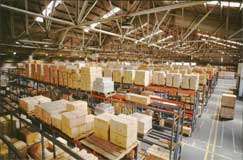| |
|
| |
|
 |
Supply
Chain by the Numbers |
| |
|
| |
- Jan. 7, 2021
|
| |
|
| |
|
| |
|
| |
US Manufacturing Sees Big Jump in December; Amazon Adds More Planes to Cargo Fleet; US Holiday Retails Sales See Modest Growth; We Need More DC Automation to Gain Space |
| |
|
| |
| |
| |
| |
60.7 |
|
That was the level of the US Purchasing Managers Index for December, according to data released Tuesday by the Institute for Supply Management. That was up 3.2 percentage points from the November reading of 57.5, and puts the index well over the 50 mark that separates US manufacturing expansion from contraction. It is also the highest level for any month of 2020. In good news for future manufacturing activity, the New Orders Index registered a robust 67.9 in December, an increase of 2.8 percentage points compared to the 65.1 reported in November. This indicates that new orders grew for the seventh consecutive month. To be clear, December's score of 60.7 does not mean US manufacturing output was greater than in February, when the score was 50.1 - it wasn't. What it means is that a higher percentage of manufacturers say they saw growth last month than they did in February.
|
|
|
| |
| |
|
|
 |
That is the modest level of total US retail sales grew a over the extended 75-day holiday period, versus a forecast of 2.4%, according to Mastercard SpendingPulse, which tracks online and in-store retail sales across all payment methods. This year, Mastercard measured spending over an extended holiday period, from Oct. 11 through Dec. 24, because many retailers started the sales season early to disperse crowds. Within the traditional holiday period from the start of November to Christmas Eve, sales grew only 2.4%, according to the report. In the extended period, on-line sales rose a whopping 49% from a year ago, according to the Mastercard data. Other estimates will be coming from other sources soon, including the National Retail Federation. |
| |
| |
|
|
| |
| |
140 Million |
 |
That's how many square feet of distribution space the US may be short in five years, as structural changes in the market driven by – what else – ecommerce - continue. In fact the shortage may limit some rapid deliveries because local space is not available. That according to a new report from warehouse real estate developer Prologis. Its estimate would mean, for example, the US market would need an additional 280 500,000 square feet DCs than what is available five years hence. What's the answer? DC automation, Prologis says. Its research finds that automation has the potential to greatly increase revenue generated per square foot of logistics space, with greater productivity able to offset a lack of available space, especially in locations near urban areas that have vacancy rates that are often under 1%. It also says too many DC automation projects are focused almost exclusively on potential labor savings - and not enough on space efficiency. |
| |
| |
| |
| |
| |
|
|
|
| |
 |
 |
| |
 |
![]() |
 |
|
| |
 |
Feedback |
|
|
|
![]()
|
No Feedback on this article yet.
|
|
![]() |
|
|
|
![]() |
 |
![]() |
 |
|
| |